The issue of how to prevent flies on a ruminant farm has always been a very big challenge to most ruminant farmers because flies do multiply rapidly where dungs are piled up on the farm. So to prevent this, always maintain good hygiene by ensuring the following measures:
1. Ensure to pack their dungs and prevent them from becoming breeding site for flies.
2. Let their housing be washed as regularly as desired and in case you are still being disturbed by flies after this, then go for drugs like pour-on that do scare flies away from ruminants. In case you need further help then consult an expert around you.
You should not wait until a problem exists to begin a fly control program. Flies are among the most difficult pests to control. A good program needs to be in place before fly numbers increase. Often flies are hidden during a portion of their lifecycle making them undetectable.
Knowing when and where they may be found increases the ability to limit potential losses in your animal’s performance. Proper identification of the fly and knowledge of the life cycles is important to help to target control measures. The following four flies are the more common ones found around livestock and horse areas.
The Horn Fly and Face Fly cause problems in pasture situations, while the House Fly and Stable Fly are a problem around barns and stable areas.
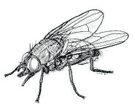
Horn Flies– They are dark gray in color with two transparent wings folded flat over the back, often in a delta wing position. Their life cycle is completed in 8 to 45 days depending on temperature and humidity.
The horn fly rests on different parts of the host’s body on light or dark-colored patches of hair (dark when cool and light when hot) and underside during rain or heat. Horn flies will only leave their host when they lay eggs, move to other cattle in the herd, or when the cattle enter buildings.
Most of the feeding occurs along the underline of the animal and often bloody, scabby sores can be seen. The horn fly can feed from 10 to 38 times per day and this results in irritation to the host and decreased grazing time and thus reduced weight gains and milk production.
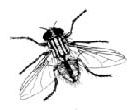
House Flies– The adult house fly is very similar in appearance to stable flies and develop in fresh manure. The life cycle is about two weeks. House flies can not pierce the skin of an animal; instead they feed on animal wastes, decomposing feeds, and other liquefied organic matter. Numerous animal and human diseases can be traced back to the house fly.
Read Also: How to Introduce New Animals into your Ruminant Farm
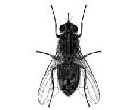
Stable Flies– They resemble the common house fly except that they have checkerboard markings on the underside of their abdomen. Life cycle is 3 weeks in the summer and longer in cooler weather.
They feed on most species of livestock, but are most prevalent on cattle and horses. The primary area that they feed (suck blood) is on the front legs causing the animal to bunch in a circle to protect their front legs.
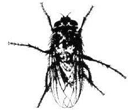
Face Flies– The adult face fly is similar to the house fly except that it is larger and darker in color. They are more prevalent on cattle and horses and are considered a serious pest.
Face flies are non-biters that feed on secretions, nectar and cluster around the animal’s eyes, mouth, and muzzle. These flies serve as vectors of eye diseases such as pinkeye and eyeworms. They have a high longevity, over wintering in homes and barns.
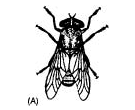
Horse Flies– Are large biting flies which can inflict painful bites on horses and humans. Horse flies have been incriminated in the transmission of equine infectious anemia.
Further, because the bite is painful, horses may become restless and unmanageable when they attempt to ward off attacks by these flies. Life cycles are long. Only female flies feed on blood.
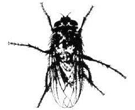
Black Flies – Black flies are small, 1/12 to 1/15 inch long, hump backed; biting flies which may have high populations in the spring and early summer, particularly in pasture areas along streams.
The immature stages are found in flowing water. Pupation occurs underwater and the adults float to the surface, ready for flight, feeding, and mating.
Adult feeding on horses and other animals can pose serious animal health problems, and the irritation caused by black fly bites can make horses unmanageable. A large numbers of bites may cause weakness from blood loss, anaphylactic shock, or death.
Read Also: Signs of Ruminant Animals on Heat
Best Management Practices to Control Flies on a Ruminant Farm
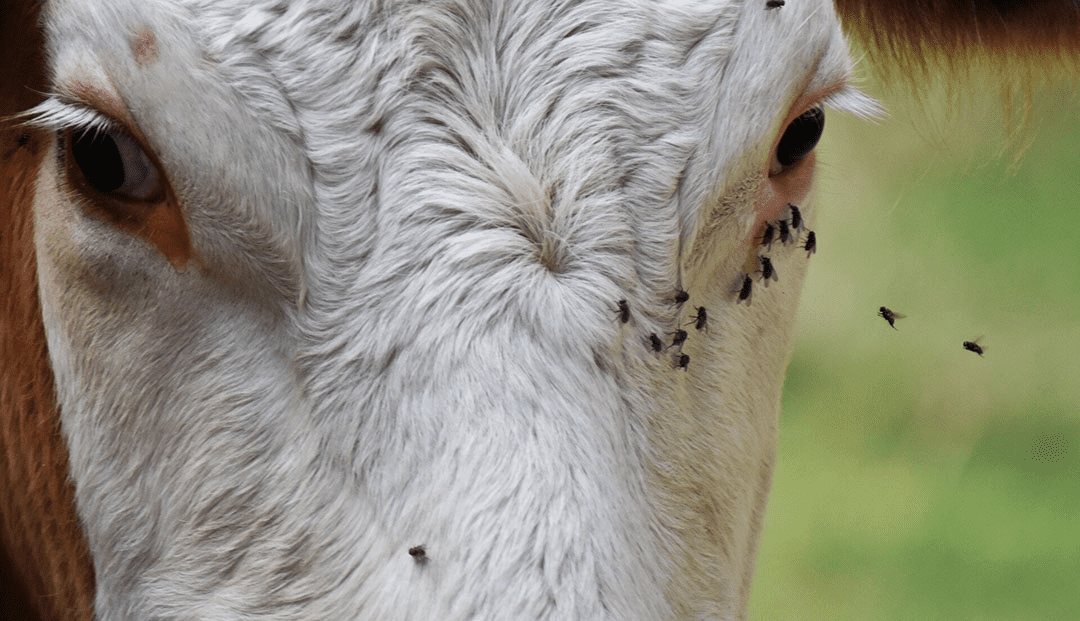
Sanitation is the most important factor in any fly control plan. Manure and other organic fly breeding material should be regularly removed from barn and stable areas. Composting manure can also aid in fly control.
The heat generated by proper composting will kill fly eggs, therefore reducing fly populations. Clean up spilled feed and other organic materials to prevent additional fly breeding grounds. Automatic waterers should also be properly cleaned and maintained.
Treatments
1. Horn Flies – Sprays can be used but need frequent reapplication. Dust bags and back rubbers work well, but animals must be forced to use them. For a non- insecticide option, a walk through fly trap can be positioned by gates where livestock pass through. Feed additives can also be used for controlling fly larvae developing in manure.
2. House and Stable Flies – Sanitation is the key in controlling house flies. Sprays do not work well on animals since the flies are only on them for a short period of time.
Feed additives are available but not effective for adult flies or larvae that develop in organic material other than manure. Residual sprays can be effective as a surface treatment where flies lay.
3. Face Flies – Control of face flies is difficult. Much effort has been made using various insecticides and application techniques, such as dust bags, mist sprays, and wipe-on formulations. Also, insecticides and insect growth regulators are used as feed additives.
However, results are usually less than satisfactory. The introduction of insecticide-impregnated ear tags has provided somewhat better control. Fly repellent can be wiped around the horse’s face and when turning out a horse, use a properly-fitted fly mask to keep flies away from the face while grazing.
You can buy masks that include ear and nosepieces as well as eye protection to cover as much of the face as possible. Be sure to wash the mask when it becomes dirty to ensure visibility.
4. Horse Flies – Control is difficult; individual animal treatment using repellents or insecticidal sprays may reduce fly bites.
5. Black Flies – Control is difficult; species which feed in the ears of horses can be controlled using insecticidal applications or by using petroleum jelly in the interior of the horses’ ears. Fly masks have also been known to help.
When possible, horses can be stabled during the day and pastured at night. Black flies only feed during daylight hours and usually do not enter stable areas. Area sprays or general topical applications of insecticides are not very effective.
Other Control Measures for Flies on a Ruminant Farm
1. Ear Tags
Insecticide ear tags are one of the best devices for deterring flies. Harmlessly hung in the animal’s ears, these tags are packed with various chemical compounds that can protect your herd from horn flies and biting lice.
This is a proactive approach that can ultimately save you money and grief! Make sure you put tags in each ear and also put them on your calves. Only putting the tags in one ear will be ineffective.
2. Fly Predators
Not all flies are bad. Fly predators, nature’s own self-inflicted enemy, can be your ally in the fight against pest flies. These are tiny, non-stinging, non-biting wasps that feed on fly larvae and interrupt the breeding cycle of flies, destroying the next generation of flies before they hatch into disease-carrying adults.
Fly Predators work by both laying eggs in the fly pupa (or cocoon) and feeding on fly larvae while it’s in the manure on your farm. The wasps “bug” the bugs but never disturb the cattle, pasture plants, or humans for that matter.
Although a natural method of controlling flies, fly predators aren’t typically found in large enough amounts to control the entire fly population on your farm. However, many companies sell fly predators and can ship them straight to your farm. Once they arrive, all you have to do is sprinkle the predators on manure piles at dusk and watch them go to work.
As a rule of thumb you should replenish your fly predator supply once a month from April to September. It’s important to use them during the entire fly season; otherwise the fly life cycle will only be broken for a few weeks.
3. Dust bags and Back rubbers
Dust bags are a low maintenance, highly effective method of combating troublesome flies. After application, the dust will control horn flies and lice on beef and dairy cattle. The bags of dust are hung across gates or doorways and are easily refillable.
The most effective place to hang your bag is a place where the cattle pass by on their way to their water tank. This is known as a forced-use situation.
You’ll want to hang it low enough so it’s effective on small calves as well as adult animals. If hung and maintained properly, the bags will last for several seasons.
Cattle tend to rub up against objects when they are being pestered by bugs. The backrubber is a rubber surface that is soaked with a pesticide that will deter flies. Your herd will rub up against it and wah-lah insecticide applied.
4. Walk-through fly traps
Another environmentally-friendly way to get rid of flies is with a walk-through fly trap. As horn flies spend the majority of time during the summer on the backs and sides of cattle, this trap helps reduce their numbers. As cattle walk through the device, the flies are brushed off of them.
5. Insect Growth Regulator
Feed-through fly prevention supplements and minerals can help rid your facility of horn flies and other manure-lying pests. Insect growth regulators are added to manure, interrupting the life cycle of flies and eliminating the spreading of breeding.
They are typically only effective against premature house and stable flies, but can significantly reduce the fly population harassing your herd.
Read Also: List of Problems Confronting Livestock Production
